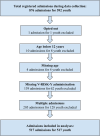Predictive accuracy of the Violence Risk Assessment Checklist for Youth in acute institutions: A prospective naturalistic multicenter study
- PMID: 39801327
- PMCID: PMC11822959
- DOI: 10.1192/j.eurpsy.2025.3
Predictive accuracy of the Violence Risk Assessment Checklist for Youth in acute institutions: A prospective naturalistic multicenter study
Abstract
Background: Acute health and social services for children and adolescents often struggle with youth aggression and violence. Early identification of violence risk during institutional stay can help prevent violent incidents. As such, this study assessed the predictive accuracy of the Violence Risk Assessment Checklist for Youth (V-RISK-Y) aged 12-18 in two different juvenile settings providing 24-hour services for youth. Institutions were included from child and adolescent inpatient psychiatry and residential youth care under child protective services.
Methods: A prospective, naturalistic observational study design was employed. V-RISK-Y was administered for youth admitted to four acute inpatient psychiatric units and four acute residential youth care institutions. Incidents of violence and threats during the youth's stay were registered by institutional staff. In total, 517 youth were included in analyses, 59 of whom were registered with at least one incident of violence or threats during their stay. Area under curve (AUC) and logistic regression analyses were used to assess predictive accuracy and validity of V-RISK-Y.
Results: For the overall sample, V-RISK-Y had good predictive accuracy, and the sum score of V-RISK-Y significantly predicted registered violent incidents. Stratified analyses indicated good predictive accuracy of V-RISK-Y for the inpatient units, but not for the residential youth care institutions.
Conclusions: Findings imply that V-RISK-Y is accurate in identifying violence risk for youth admitted to inpatient psychiatric units but has limited predictive accuracy in residential youth care institutions. Future research should explore approaches to correctly identify violence risk in residential care settings.
Keywords: V-RISK-Y; emergency psychiatry; residential youth care; violence risk screening; youth violence.
Conflict of interest statement
Some of the authors of this paper (SB; JOR) were involved in the development of V-RISK-10 and V-RISK-Y. These authors have not received, and will not receive, any financial benefits from the use of the instrument, which it is freely available online. The first author was not involved in the development of these instruments and is employed by an institution other than the one where the instruments were developed. Authors have strived to conduct the study with objectivity and transparency, with the goal of enhancing the scientific understanding of V-RISK-Y. We believe that the design of the study mitigate potential bias that could arise from the authors involvement in the instrument development.
Similar articles
-
Interrater reliability of the violence risk assessment checklist for youth: a case vignette study.BMC Psychiatry. 2024 Apr 23;24(1):303. doi: 10.1186/s12888-024-05746-8. BMC Psychiatry. 2024. PMID: 38654194 Free PMC article.
-
Validation of a violence risk screening for youth in psychiatric inpatient care-a pilot study of V-RISK-Y.Front Psychiatry. 2023 Jul 26;14:1210871. doi: 10.3389/fpsyt.2023.1210871. eCollection 2023. Front Psychiatry. 2023. PMID: 37614654 Free PMC article.
-
Predictive Validity of the Brøset Violence Checklist in a Secured Institution for Offenders With Intellectual Disabilities.J Intellect Disabil Res. 2025 Jun;69(6):518-526. doi: 10.1111/jir.13233. Epub 2025 Mar 20. J Intellect Disabil Res. 2025. PMID: 40114337 Free PMC article.
-
Development and evaluation of a de-escalation training intervention in adult acute and forensic units: the EDITION systematic review and feasibility trial.Health Technol Assess. 2024 Jan;28(3):1-120. doi: 10.3310/FGGW6874. Health Technol Assess. 2024. PMID: 38343036 Free PMC article.
-
Is mental health staff training in de-escalation techniques effective in reducing violent incidents in forensic psychiatric settings? - A systematic review of the literature.BMC Psychiatry. 2023 Apr 12;23(1):246. doi: 10.1186/s12888-023-04714-y. BMC Psychiatry. 2023. PMID: 37046228 Free PMC article.
Cited by
-
Instruments for Short-Term (24 h) Violence Risk Assessment and Strategies for Managing Violence Risk Among Adolescents With Risk for Violent Behaviour: A Systematic Review.Int J Ment Health Nurs. 2025 Jul;34(4):e70110. doi: 10.1111/inm.70110. Int J Ment Health Nurs. 2025. PMID: 40757747 Free PMC article.
References
-
- Koh LL, Day A, Klettke B, Daffern M, Chu CM. The predictive validity of youth violence risk assessment tools: a systematic review. Psychol Crime Law. 2020;26(8):776–96.
-
- John JR, Thavalingam V, Tye M, Dean K, Barzman D, Sorter M, et al. Appraising risk factors of aggression in children and adolescents at psychiatric inpatient units. Psychiatry Res. 2023;327(Sep):115368. - PubMed
-
- Svalund J. Violence and threats of violence in public sector. Oslo, Norway: Fafo: 2009. Report: 32.
-
- Bergsund HB, Nøkleby H. The use of force and limit-setting for children and youth in residential childcare and foster care: systematic scoping review. Oslo, Norway: Norwegian Institute of Public Health: 2023.
-
- Nielsen MB, Parveen S, Finne LB. Forekomst av vold, trusler og netthets mot barnevernsansatte. Tidsskriftet Norges Barnevern. 2023;100(4):206–23.
Publication types
MeSH terms
LinkOut - more resources
Full Text Sources
Research Materials


